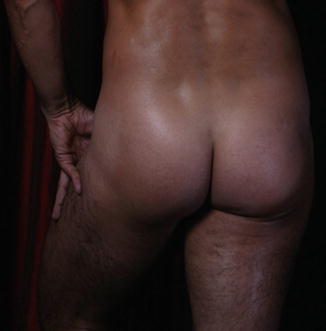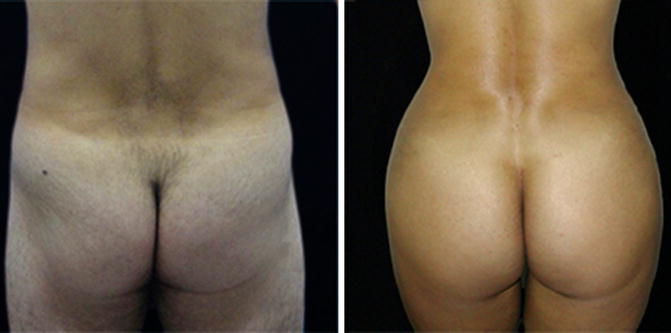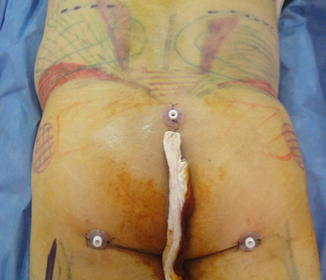and Peter M. Prendergast2
(1)
Elysium Aesthetics, Bogota, Colombia
(2)
Venus Medical, Dublin, Ireland
Introduction
The gluteal area in men is defined by the shape and volume of the gluteus maximus muscle. A well-developed and aesthetically pleasing gluteal region is a trait unique to primates, which is an evolutionary adaptation to erect posture and bipedal locomotion. The gluteus maximus muscle and fat deposits in the superficial fascia largely form the buttock projection. In addition, our erect posture contributes to the lumbosacral curve, which is also unique to primates (Fig. 12.1).


Fig. 12.1
Athletic male buttocks
In terms of evolutionary instincts, a developed gluteal region and muscular lower limbs denote power and strength. These are traits that make for a good hunter and thus a good provider. Well-defined, muscular buttocks, therefore, correlate closely with physical attractiveness [1]. It is the muscularity, shape, and definition of the male buttocks that are cues for sexual attraction, and not merely the size. Large, rounded, buttocks in obese patients are not cues for attractiveness. Intramuscular fat grafting combined with high-definition liposculpture improves the gluteal region and the overall body shape by uniting the torso with the muscular lower limbs [2–4].
The male buttock shape is different than the female counterpart. While in females the silhouette forms a smooth curve from the waistline onto the hips and the leg without sharp edges, in men it is sharp edged by definition. The form of the female buttocks is almost hemispherical, whereas in men it tends to be square. One of the key surface anatomical features in men is the presence of the trochanteric depression. This concavity on the lateral surface of the buttocks highlights the definition of the gluteus muscles along its perimeter. In the female buttocks, an obvious trochanteric depression is not preferred (Fig. 12.2).


Fig. 12.2
Comparison between male and female buttocks: female contour is more rounded with a smooth transition in the trochanteric depression, which should not be noticeable. In men, a more squared shape is desirable, also a visible trochanteric depression gives an idea of high muscular development
There is an important relationship between the buttocks and thighs in males. The male fat anatomy shows a fusion between the superficial fascia and the deep tissues in the lateral thigh. This usually necessitates treating the gluteal and thigh regions together as one aesthetic unit. The high density of deep fat in the buttocks makes it behave like superficial fat. Hence, there is little room for fat storage in the lateral thigh and in the gluteal area in men. The majority of male patients who seek contouring of the buttock area request augmentation rather than reduction. There are exceptions. Male patients with gynecoid features require liposculpture of the buttocks and thighs to define the muscles and produce a convincing picture of athleticism and strength [5, 6].
Stealth Incisions
Three main incisions are used: the first is in the intergluteal crease. This allows the surgeon to reach the superior gluteus, the lower back, and part of the midgluteal area. The second incision is made in the midpart of the infragluteal crease (see below), allowing easy access to the lower gluteal area. The inner thigh can be reached by the lower pubic incisions with the patient supine and by the infragluteal crease incisions for posterior access with the patient prone. In cases when full leg definition is wanted, two additional incisions can be placed in the posterior fold of the knee area: one medial and one lateral (Fig. 12.3).


Fig. 12.3
Incision and ports sutured in place
The Use of Drains
As we stated in the previous chapter, the intergluteal incision is either left open for permissive drainage or a closed drain is placed in it. The infragluteal fold incisions should always be closed by subdermal sutures, since these are the ports of entry of fat grafting, to prevent protrusion of fat or migration. The posterior knee-fold incisions can be closed or left open for drainage.
Markings
Deep Markings
The ideal buttock shape in males resembles the shape of the underlying gluteus maximus muscle. The absence of fat is the standard, so there is little space for transition areas in this specific region. Later in the female chapters, we will observe that the gluteal area has specific zones for smooth contour, while in men sharp edges are often desired to produce a sculpted, muscular appearance. Usually the perigluteal area in males does not have a lot of excess fat, but the inner thigh can store some fat. This is marked for resection.
Framing
The superior portion of the gluteal area is discussed on the previous chapter. However, it is important to remember the definition zones:
With the patient in the upright position, begin by identifying the superior gluteal edge. Pressing over the superior aspect of the buttocks while the patient contracts the muscle helps define the superior gluteal edge.
Stay updated, free articles. Join our Telegram channel

Full access? Get Clinical Tree








